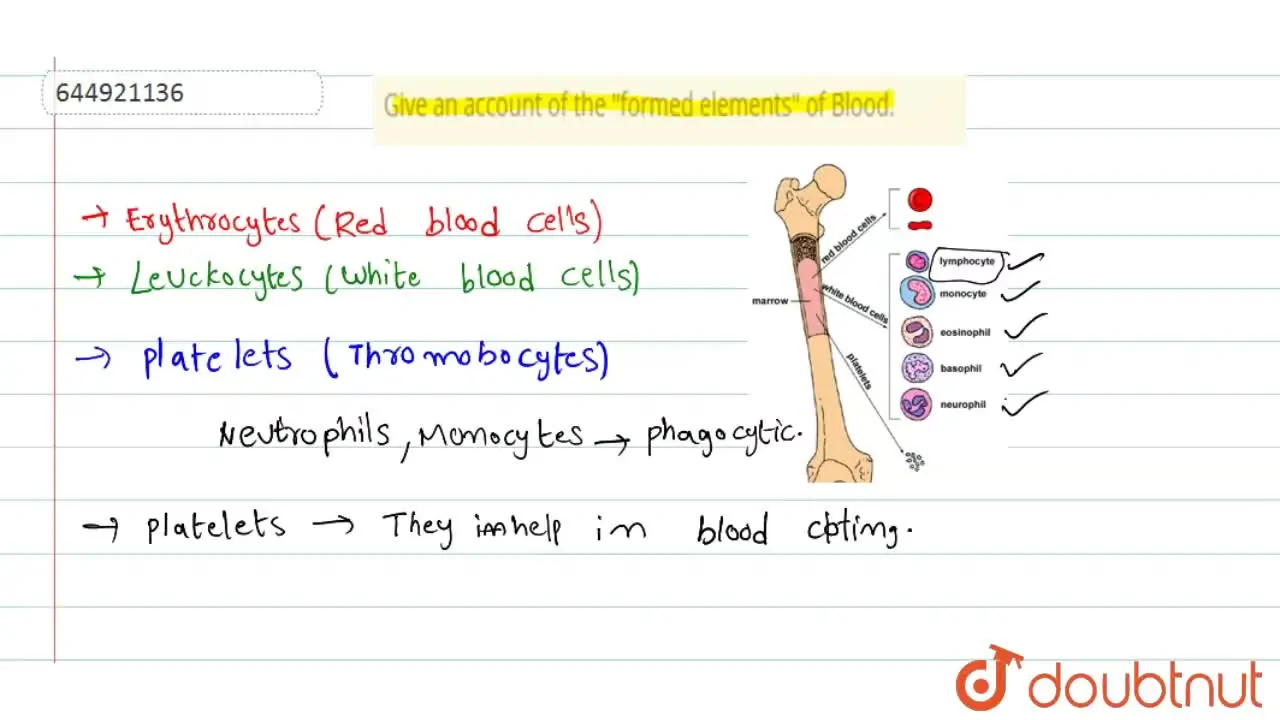Give an account of the "formed elements" of Blood.Solution in Telugu
Blood is a red coloured, opaque and slightly alkaline fluid. It is composed of blood plasma and formed elements or blood cells - the RBC, WBC and platelets..
Formed elements of Blood cells : The blood corpuscles (RBC and WBC) constitute 45% of the total blood by volume.
i) Red blood corpuscles (Erythrocytes) : Erythrocytes of mammals are circular elliptical in camels and Liamas), biconcave.and enucleate. The biconcave shape provides a large surface area-to-volume ratio, thus providing more area for the exchange of gases. These are 7.8 um in diameter. The number of RBC per cubic millimeter of blood is about 5 million in a man and 4.5 million in woman.

ii) White blood corpuscles (Leucocytes) : These are nucleate, colourless, complete cells. They are spherical or irregular in shape, and are capable of exhibiting amoeboid movement into the extravascular areas by diapedesis. WBC are two main types : 1) Granulocytes and 2) Agranulocytes.
Granulocytes : They possess cytoplasmic granules that may take three different types of stains, neutral or acidic or basic. Nucleus of the granulocytes is divided into lobes and assumes different shapes, hence, these are also called polymorphonuclear leucocytes. Based on the staining properties these are of three types.

Basophils - They constitute about 0.4% of the total leucocytes. Nucleus is divided into irregular lobes. Cytoplasmic granules are fewer. and .irregular. in shape. They take basic stains. They produce heparin, histamine, etc. They supplement the function of mast cells when needed.
Eosinophils (acidophils) : They constitute about 2.3% of the total leucocytes. Nucleus is distinctly bilobed. Cytoplasm has large granules which stain with acidic dyes such as .eosin..
Neutrophils : They constitute about 62% of the total leucocytes. Nucleus is many lobed (2-5). Specific cytoplasmic granules are small and abundant. They stain with neutral dyes.
Agranulocytes : Cytoplasmic granules are absent in agranulocytes. Nucleus of these cell is not divided into lobes. These are.of two types:
a) Lymphocytes : They constitute about 30% of the total leucocytes. They are small, spherical cells with large spherical nucleus and scanty peripheral cytoplasm. There are functionally two types of lymphocytes - .B. lymphocytes, which produce .antibodies and T lymphocytes which play the key role in the immunological reactions of the body.
Some lymphocytes live only a few days, while others survive for many years.

B. Monocytes : They constitute about 5.3% of the leucocytes: The nucleus is kidney shaped (reniform). These are the largest, motile phagocytes. They engulf bacteria and cellular debris. They differentiate into macrophages, when they enter the connective tissues.

v. Blood platelets (Thrombocytes): These are colourless non-nucleated, round or oval biconvex discs. Number of platelets per cubic mm of blood is about 2,50,000-4,50,000. They are formed from giant megakaryocytes produced in the red bone marrow by fragmentation. The average life-span of blood platelets is about 5 to 9 days. They secrete thromboplastin and play an important role in blood clotting.
They adhere to the damaged endothelial lining of capillaries and seal minor vascular openings.

Related Playlists
- BOOK - VIKRAM PUBLICATION ( ANDHRA PUBLICATION)CHAPTER - STRUCTURAL ORGANISATION IN ANIMALS EXERCISE - Important Question24videos
STRUCTURAL ORGANISATION IN ANIMALS
- BOOK - VIKRAM PUBLICATION ( ANDHRA PUBLICATION)CHAPTER - STRUCTURAL ORGANISATION IN ANIMALS EXERCISE - Short Answer Type Questions15videos
STRUCTURAL ORGANISATION IN ANIMALS
- BOOK - VIKRAM PUBLICATION ( ANDHRA PUBLICATION)CHAPTER - SEXUAL REPRODUCTION IN FLOWERING PLANTSEXERCISE - Important questions13videos
SEXUAL REPRODUCTION IN FLOWERING PLANTS
- BOOK - VIKRAM PUBLICATION ( ANDHRA PUBLICATION)CHAPTER - TAXONOMY OF ANGIOSPERMS EXERCISE - IMPORTANT QUESTIONS10videos
TAXONOMY OF ANGIOSPERMS
Similar Questions
What is tissue level of organisation among animals? Which metazoans do exhibit this organisation?
06:51View SolutionDescribe the four different levels of organization in metazoans.
02:46View SolutionName the component cells of the "egg apparatus" in an embryo sac.
View SolutionWhat is Omega Taxonomy ?
02:11View SolutionFormed Elements Of Blood
02:11View SolutionName the various types of formed elements present in the blood.
02:46View SolutionGive the meaning of accountability as an element of delegation.
02:16View SolutionName the formed elements of Blood.
01:35View SolutionName the formed elements of Blood.
02:33View SolutionGive the names of various types of formed elements present in the blood.
01:30View SolutionThe volume occupied by formed elements in the blood is
03:58View SolutionWhat are formed elements are blood?
03:55View SolutionWhich element accounts for 93% of total cations in blood or which is the principal cation in the plasma of blood?
13:55View SolutionFormed elements constitute nearly__ per cent of the blood
04:22View SolutionGive a brief account of inner transition elements.
01:56View Solution


